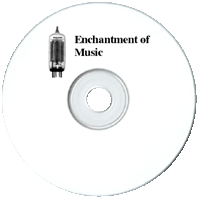

Classical music was a staple programming choice on Armed Forces Radio and Television Services broadcasts and became rather popular during the 1950's.

18 old time radio show recordings
(total playtime 8 hours, 59 min)
available in the following formats:
1 MP3 CD
or
9 Audio CDs
Text on OTRCAT.com ©2001-2025 OTRCAT INC All Rights Reserved. Reproduction is prohibited.
"Light Classic music from California, designed for pleasant listening to melodies of the Masters, Old, and New"

President Eisenhower's doctrine of "Massive Retaliation" increased emphasis on air- and nuclear-power, and this rise in machine warfare fueled the need for technically trained enlisted personnel. This also led to a huge number of young, well-trained veterans who were hitting the coming home at the prime of their lives, usually with at least some money in their pockets. Two signs of a recent veteran were a complicated Japanese camera (and often endless slide shows of the exotic places they visited while serving) and an even more complicated HiFi rack stereo system purchased at a deep discount through the Post Exchange.
Advances in high fidelity sound reproduction were occurring at a fairly constant rate ever since Thomas Edison developed the phonograph and telephone technology came out of the labs of Alexander Graham Bell. Conductor Leopold Stokowski and the Philadelphia Orchestra assisted with some experiments at Bell Laboratories in the Thirties involving recordings of performances over telephone lines. Advances in electronics, many developed for WWII technological advances, began to trickle down to hobbyist audiophiles and their developments were adopted by high-end stereo manufacturers. Systems using this new technology were available to servicemen through the Exchange system, but being too big to keep in a barracks, often found their way back to Mom's house where younger brothers and sisters would enjoy them.
Classical music was a staple programming choice on Armed Forces Radio and Television Services broadcasts and became rather popular considering that most G.I.s would have had little or no exposure to "long-hair" music before entering the service. A terrific introduction to classical music came from The Enchantment of Music program originating from Southern California.

98.7 on the FM dial was occupied by KMGM, a station run by the Metro-Goldwyn-Meyer movie studios beginning in 1948, but since the studio had no real use for an FM station, it was shut down in 1953. The following year, the station, studio, and all of its broadcasting equipment were purchased by Art and Jean Crawford, owners of Crawford's of Beverly Hills Record and HiFi Store on the soon-to-be exclusive Rodeo Drive. The newly-christened KCBH featured a classical music format and presented high fidelity stereo broadcasts at a time when no one really knew what to do with FM radio.
The Enchantment of Music was a collection of concerts of "Light Classic music from California, designed for pleasant listening to melodies of the Masters, Old, and New". Recordings of the Royal Philharmonic Orchestra, the French National Radio Orchestra, the Cincinnati Pops, the Detroit Symphony Orchestra, the Boston Pops, The Capitol Orchestra, and several others were featured on the program.
AFRTS considered the content of The Enchantment of Music to be "dinner music", but the dramatic and beautiful melodies are perfect accompaniment for many occasions.
For additional classical and opera radio shows, see also:
Text on OTRCAT.com ©2001-2025 OTRCAT INC All Rights Reserved. Reproduction is prohibited.
You have reached the maximum number of votes for a unregistered user.
Please login or create a new account to continue...
You have reached the maximum number to down votes in this page.



Enchantment of Music Disc A001
|
Add Audio CD to Cart - $5.00 |
Enchantment of Music Disc A002
|
Add Audio CD to Cart - $5.00 |
Enchantment of Music Disc A003
|
Add Audio CD to Cart - $5.00 |
Enchantment of Music Disc A004
|
Add Audio CD to Cart - $5.00 |
Enchantment of Music Disc A005
|
Add Audio CD to Cart - $5.00 |
Enchantment of Music Disc A006
|
Add Audio CD to Cart - $5.00 |
Enchantment of Music Disc A007
|
Add Audio CD to Cart - $5.00 |
Enchantment of Music Disc A008
|
Add Audio CD to Cart - $5.00 |
Enchantment of Music Disc A009
|
Add Audio CD to Cart - $5.00 |
Please wait...
COMMENTS
Be the first to comment on "Enchantment of Music"
Leave a comment